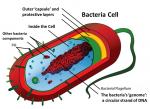|
This section contains 816 words (approx. 3 pages at 300 words per page) |

|
Eubacteria (more commonly known as bacteria) are prokaryotic microorganisms that can be found almost everywhere on Earth. They are usually single cells but can also be found in chains, filaments, or multicellular clusters. Most are about 1 micron (1 µm), or one millionth of a meter in length, although some of the largest can be up to half a millimeter (500 µm). They come in a variety of shapes such as rods, filaments, spirals, vibrio (comma-shaped), and cocci (ball-shaped). Some have stalks that can be used for attachment. Many of them can move by gliding or by rotating small, projecting filaments called flagella. They lack the complex intracellular motility and mitosis found in eukaryotic cells.
Cellular Structure
Bacterial cells are fairly simple in structure when compared to the eukaryotic cells of fungi, protists, plants, and animals. As seen with an electron microscope, the majority of bacterial cell volume is...|
This section contains 816 words (approx. 3 pages at 300 words per page) |

|


